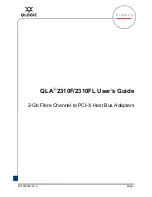
9
/INT signal level, and send a notification to the host computer when the /INT signal
changes state.
3 Hardware Configuration
3.1
Circuit Sense
The iPort/LAN 2 includes MCC’s
Circuit Sense
technology. Circuit Sense allows
the I
2
C intV pin to operate in two modes, Power Source Mode and
Voltage Sense Mode. Mode selection is controlled by the MODE slide switch on
the side of the unit enclosure.
Power Source Mode
- The +V pin can supply power (5v @ 100 mA) Vcc to an
external I
2
C Bus system. In Power Source Mode, the voltage of the iPort/LAN 2
SCL, SDA, and /INT internal pull-ups, if enabled, and Voltage Sense circuit
(0.3Vcc Low
MAX
, 0.7Vcc High
MIN
) is connected to the adapter’s +5v power
supply. (Use of the +V pin in Power Source Mode is user optional).
Power Source Mode is similar to the standard mode of operation on earlier
versions of MCC I
2
C Bus host adapters.
Voltage Sense Mode
- The +V pin is connected to the external I
2
C Bus system
pull-up supply voltage (0.5v to 5v) Vcc, and automatically adjusts iPort/LAN 2
SCL, SDA, and /INT Voltage Sense circuit levels to match (0.3Vcc Low
MAX
,
0.7Vcc High
MIN
). In Voltage Sense Mode, the voltage of the iPort/LAN 2 SCL,
SDA, and /INT internal pull-ups, if enabled, is equal to the external voltage (Vcc)
applied to the +V wire. (Use of the +V wire in Voltage Sense Mode is
REQUIRED).
3.2
Pull-up Resistors
I
2
C Bus systems are based on open-collector technology requiring pull-up devices
on each signal wire. These pull-up devices usually take the form of pull-up resistors
connected to bus power.
The I
2
C adapter includes a PULL-UP slide switch used to enable or disable internal
I
2
C Bus 1.8K ohm pull-up resistors attached to the SCL, SDA, and /INT lines.
Every I
2
C Bus system must have at least one pull-up on the signal lines. Use this
switch to configure the pull-up resistors for your system.
















































